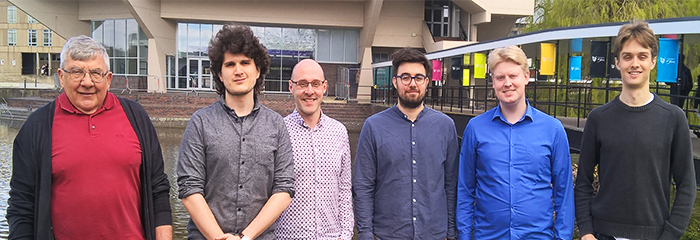Computing Atomic Nuclei
We want to compute atomic nuclei within a unified framework based on fundamental interactions between nucleons.
A recent key publication:
Ab initio derivation of model energy density functionals: J. Phys. G: Nucl and Part. Phys. 43, 04LT01 (2016)
Our work focuses on developing novel and advanced nuclear density functionals with the overarching goal of improving the precision and predictive power of nuclear density functional theory (DFT). We propose to realise this goal by building functionals based on:
- higher-order expansions of finite-range pseudopotentials
- ab initio calculations in light nuclei.
This research is proposed by the newly established nuclear theory group at York and opens up new research directions within UK nuclear theory. It responds to the need to build up theoretical research in support of UK nuclear science.
We want to compute nuclei within a unified framework based on fundamental interactions between nucleons. For heavy nuclei, this can be achieved by constructing novel EDFs based on effective theory expansions, by state-of-the-art adjustments of their coupling constants to experimental data, and by rooting their properties in ab initio results available for light nuclei.
At present, the only theoretical methodology that can handle all ground-state and low-excitation properties of nuclei across the nuclear chart is that based on DFT implemented through nuclear EDFs. For electronic systems, analogous methods have already achieved unprecedented level of sophistication, and are considered to belong to the class of ab initio methods. We aim to achieve goals that would bring nuclear modelling towards a similar level of advancement.
In recent years, it has become clear that relatively simple EDF approaches have reached their limits of applicability and have exhausted any scope to increase precision, accuracy, and predictive power. To make progress, extensions/modifications are essential. Work towards such a goal is not only important for a better understanding of nuclear phenomena as such, but also for more reliable extrapolations to the extremes of mass, spin, or isospin, which are impossible to reach in terrestrial laboratories, but essential to describe stellar environments.
Staff
- J. Dobaczewski
- A. Pastore
- J. Bonnard
PhD. Students
- P. Sassarini
- A. Romero
- M. Shelley
Main active collaborations
- FIDIPRO
- Lyon
- Warsaw
- MSU
- Valencia


